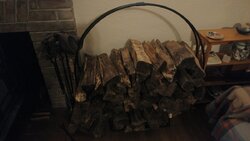Woody Stover
Minister of Fire
In your case, I might be inclined to go with a simpler non-cat stove with less maintenance.
I recently switched my SIL from a cat to a non-cat stove, the Pacific Energy Alderlea T5, and it's working well. She governs the output with load size. A new load will peak in output in the first few hours, then slowly declines as the load coals. My cat stove works much the same, peaks early, then glides down. The BKs have a thermostat which evens the output over the burn. The cast iron convective jacket on the T5 steel box buffers the initial output, then releases stored heat later.
Your climate is very mild, and if your house has decent insulation, it will hold heat well, and buffer temp changes in the house over long periods. You can use the desk fan setup I mentioned to keep the stove room comfortable and distribute the heat, depending on the floor plan.
The best thing about getting the T5 for her? Less maintenance for me. Don't get me wrong; I love my little cat stove too, and don't have a lot of maintenance except to replace the cat every four years or so. It's also got a grated ash-handling system, which I discovered when I got the used Dutchwest back around the turn of the century. It's not likely that I'll ever go back to the more primitive methods of removing ash...I'm spoiled.
Don't get me wrong; I love my little cat stove too, and don't have a lot of maintenance except to replace the cat every four years or so. It's also got a grated ash-handling system, which I discovered when I got the used Dutchwest back around the turn of the century. It's not likely that I'll ever go back to the more primitive methods of removing ash...I'm spoiled. 
I recently switched my SIL from a cat to a non-cat stove, the Pacific Energy Alderlea T5, and it's working well. She governs the output with load size. A new load will peak in output in the first few hours, then slowly declines as the load coals. My cat stove works much the same, peaks early, then glides down. The BKs have a thermostat which evens the output over the burn. The cast iron convective jacket on the T5 steel box buffers the initial output, then releases stored heat later.
Your climate is very mild, and if your house has decent insulation, it will hold heat well, and buffer temp changes in the house over long periods. You can use the desk fan setup I mentioned to keep the stove room comfortable and distribute the heat, depending on the floor plan.
The best thing about getting the T5 for her? Less maintenance for me.
 Don't get me wrong; I love my little cat stove too, and don't have a lot of maintenance except to replace the cat every four years or so. It's also got a grated ash-handling system, which I discovered when I got the used Dutchwest back around the turn of the century. It's not likely that I'll ever go back to the more primitive methods of removing ash...I'm spoiled.
Don't get me wrong; I love my little cat stove too, and don't have a lot of maintenance except to replace the cat every four years or so. It's also got a grated ash-handling system, which I discovered when I got the used Dutchwest back around the turn of the century. It's not likely that I'll ever go back to the more primitive methods of removing ash...I'm spoiled. 



 Rent was cheap, though..
Rent was cheap, though.. 